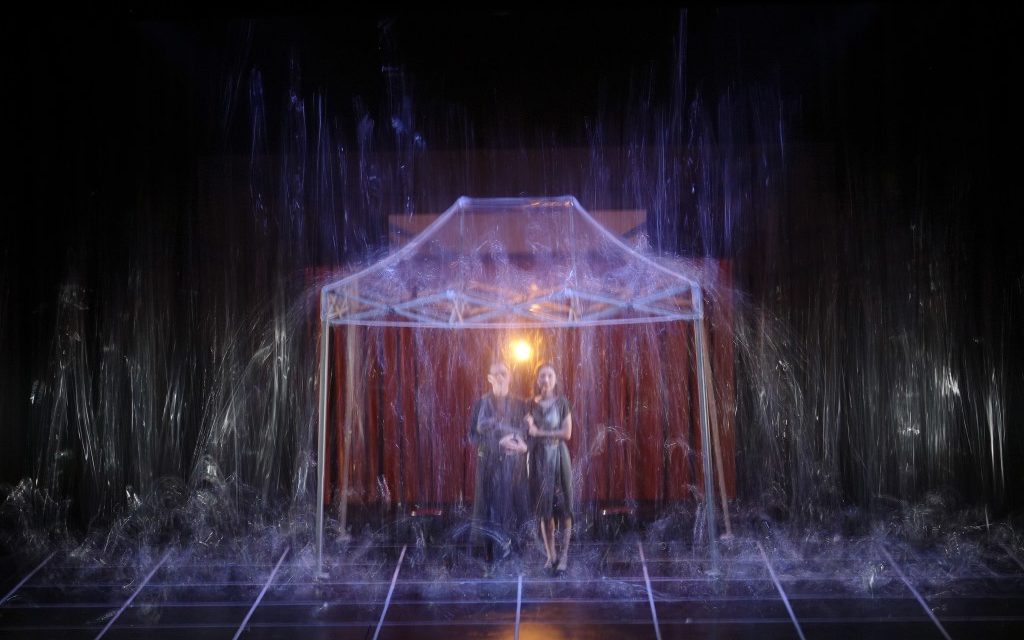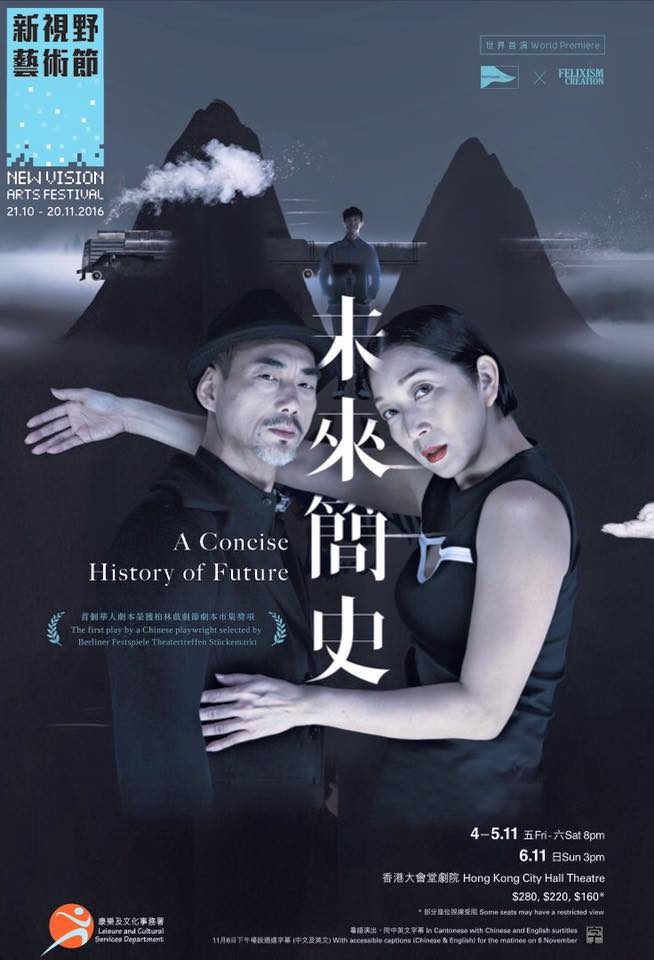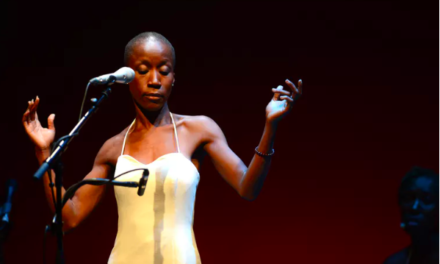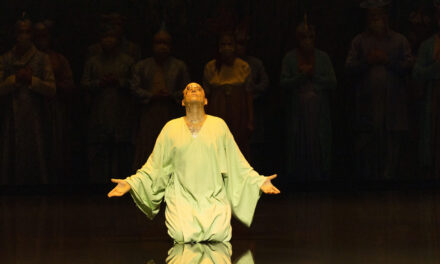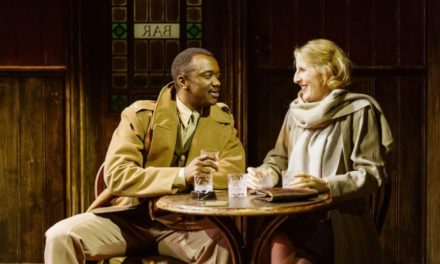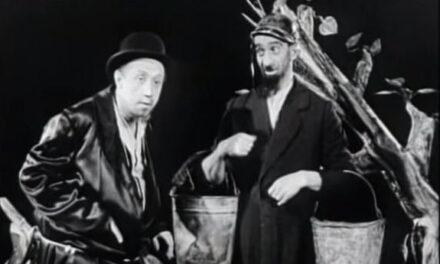A Concise History of Future, Yan Pat-to’s new Berlin Theatertreffen Stückemarkt award-winning play, premiered at Hong Kong City Hall Theatre last November. This production, also directed by Mr. Yan, was a dream-like poetic journey with strong vision. It is the first play by a Chinese playwright selected by Berliner Festspiele Theatertreffen Stückemarkt.
A country on the brink of civil war. Two generations, two cities, two opposite journeys. While the entire population is fleeing towards the South, the outsider struggles to get to the North in order to fulfil his mission. Time levels intermingle. With nowhere to run or hide, where is history headed? Defying the linear narrative, witness barbarism unfolds in asynchrony.
Journey to the North vs. Journey to the South
It is no doubt that Mr. Yan really concerns about the political situation in Hong Kong in the past few years. His two previous works, The Sorrows of Young Yat Sum and White Blaze of the Morning, are two indirect portraits of the youths under the Umbrella Movement in 2014. It consists a lot of monologues and internal reflections of ordinary lives. A Concise History of Future, still hovering on the same themes, is however much more epic, and I am glad that Mr. Yan has reached to the next level of writing.
The premise is simple yet not simple at the same time: An outsider from the future wants to bring a box to the Capital Theatre at the north, and along the way, we see a man who witnesses pain travels south with his wife, a sinister girl, in the same time, yet not in the same realm: one is in current, while the other is in the future. The audience goes through both of the journeys, and simultaneously, witnessing episodes of the encounters within the country, which one can relate it to a totalitarian state.
Confusing enough? There is more. This country involves familiar roles, like a judge, a comrade, a chairman of some factory, etc. On the other hand, characters who are from ancient classics, like Antigone and the White Bone Lady from The Journey to the West, or straight out of imagination, like a cat with a hole, the man who exists without a heartbeat, and the robots, also make appearances along the way.
The play requires a lot of storytelling within the story, as well as playing on theatrical references: the journey to the Capital Theatre; the sinister girl declares in the very beginning that she is not going to see anymore musical, while she was a musical theatre actress, and gave a detailed account on how she involved in musicals; the man who witnesses pain shares his past as a judge; Antigone makes a statement about the illegal burial of her brother; the White Bone Lady talks about her previous occupation as a robot programmer, and even a robot shares a story about ‘heartless humans’ at the end of the play.
“Resists any linear narrative dramaturgy, using highly concentrated poetical interweaving to elaborate the cruel phantasms of a contemporary society of asynchronies” – Kathrin Roggla (Jury member, Berliner Festspiele Theatertreffen Stückemarkt 2016)
 An Adventure Between Reality and Illusion
An Adventure Between Reality and Illusion
So you might ask, where is the history? If there is a history to see, then why it is in the future? This is the clever trick that Mr. Yan has played on us. If you have read The Story of the Stone by Cao Xueqin, you would have known that the serial novel is written in the fashion of hiding the reality of what the author had experienced in his real life, and presents an illusion in details.
This writing method is what I witnessed in this piece of theatre. The play opens with the ‘musical’ scene where the sinister girl talks about her past life as a musical actress. If the play is channeling the style of The Story of the Stone, then somehow, the play already indicates that the whole play is a show. Not everything you see and hear is true.
More to that, the play is playing with the concept of parallel universes in a dream-like approach. Each scene is an encounter of a prototype of a role in a totalitarian state, every position that indicates authority, power, corruption, and exploitations. With the recent political situation in Hong Kong and in China, it is not difficult to see who these prototypes can be referred to. It seems so real and so close to us.
Yet, everything said on stage seems fake and not logical as well. Antigone was not judged and sentenced in current times with a comrade of the country as her prosecutor. She could not have resurrected and changed her name to Goneanti (the reverse of the first half and the second half of the name ‘Antigone’) and live on. The cat with a hole (this already is not logical) could not have talked to the man who witnesses pain now if she has just talked to the outsider in the future. This furthers the ambiguity between real and unreal.
Literary Skills at Best
It is no doubt that Mr. Yan’s literary skills is top-notch. Not only he manages to structure such a concept that is hard to execute, but his writing gives a refreshing tone. To me, it is a mixed vibe of lyrical subtlety in Chinese literature, German seriousness, and British humor.
Mr. Yan never delivers his messages in a blunt, visible fashion. The retelling of a person’s history, or a story, or a dream, is in beautiful poetics (though I do feel a bit tired of hearing his description of the Occupation after similar narrative was used in his previous works, but it is still a piece of good writing).
The result is that Mr. Yan has produced a theatrical statement in poetry form with a calculated sequence. Some scenes are satires (the White Bone Lady, the man without a heartbeat, and the Chairman), but some are very heavy and serious (the trial of Antigone, and the sinister girl’s monologue to her unborn son). With this structure and transitions, it does invite the audience to walk along this epic journey in a slumber pace, but also with curiosity due to its adventurous genre.
A Rare Suppressive Performance
However, the idea of playing illusion and reality of the play cannot be fulfilled without Mr. Yan’s direction for the production. Not only that the play is done in the physical form, but the design of the production, from acting design to set design to lighting design, actually becomes half of the narrative of the play.
It is refreshing to see how the play is performed. Mr. Yan, heavily influenced by the Western European style, chooses a suppressive tone for the performance. It has been a long time that I have not seen Hong Kong trained actors deliver such style of subtlety and eloquence. They show really good discipline to translate this heavy difficult piece. Though the acting ensemble’s energy is a bit scattered, it is a joy to see the piece performed in such steady drive from the company’s effort under a bold vision.
A Stage on a Stage
Art director Chow Chun-fai and set designer Yuen Hon-wai designed a black cold stage printed with sharp-lighted grid lines. Bleak lighting and music, designed by Au Yeung Hon-ki and Edmund Leung respectively, further address the hollow limbo of what the play is showing.
But among all, it is the replica of the Hong Kong City Hall Theatre (to represent the Capital Theatre in the play) on the very stage of the theatre, with the proscenium and curtain, that is, again, a surprise treat for the audience.
Though it is not something really novel, but still, it is breathtaking to see a smaller but very uncanny version of the theatre with such detail put under the actual establishment. Even the yellow curtain of the replica is made with the same fabric as the actual curtain. It really speaks, really provokes the audience to assess what they are seeing while they are experiencing such intriguing spectacle.
This idea heightens up the concept of playing a play on stage, that the character in this so-called ‘history of future’ might only be an imagination of an imagination, and it works with strength.
A Visual Display
Then, there are more gigantic visuals that really hook the audience for more engagements, which some of them, to be honest, is questionable. The simplified-Chinese surtitles shown above the replicated theatre mirroring the actual traditional-Chinese and English surtitles above the actual theatre during the trial scene is provocative.
The falling of the wall of the actual theatre, seeing a huge plank dropping diagonally from the side of the stage and stop in mid-air, though has a good symbolic meaning, is not executed at it’s best since the thin fabric hovering during the fall really suspends my belief.
One scene definitely is a shock to me, when a huge amount of plastic water bottles drop from above, jumped onto the patio and to the stage, producing a loud crash like thunder. It is really powerful, but the plastic bottles are so naked in design that I just feel a bit off from the mood of the scene, especially one of the bottles turns out is supposed to be the tool for the man who witnesses pain to make a prophecy for Goneanti.
If so, should the bottles be at least designed in some aesthetic nuances that they can merge with the rest of the scene. I just feel that it is a misstep since that scene can be much more stylish, especially with such elegant dress wore by the rebellious, authoritative heroine, designed by Ma Ka-yue.
A Not-Performed ‘Concise’ History
The ending, in return, is incredible, though. By the end, the outsider finally arrives the Capital Theatre, and he is looking at the man who witnesses pain and the sinister girl doing a musical. The theatre replica on stage is turned the other way round. Now the outsider is looking at the audience while the dancing pair is at the apron of the stage.
Just a simple turn, Mr. Yan plays with a profound idea. While the audience is coming to see the ‘Concise History of Future’, which is supposed to be done on the City Hall Theatre stage, someone is actually looking back to the audience through another theatre, which means the audience is on another stage as well.
If the play on stage is a theatre show, an illusion, then where is the history? The history turns out is actually on us: the audience. We carried the actual history of the future, but it is never performed in details on stage. And thus, it is ‘ concise’, to an extent that it actually can be barely shown.
By this, I left the theatre with satisfaction, since to articulate this strong epic vision is difficult, yet Mr. Yan shows prominent skills to deliver it.
Production Credit:
A Concise History of Future
Written & Directed by Yan Pat-to
A ‘New Vision Arts Festival’ Programme
Hong Kong City Hall Theatre
Closed on 6th November 2016
Clement Lee graduated from Royal Holloway, University of London in MA Theatre (Applied Theatre), and earned his BA English degree at University of Central Oklahoma, Lee is a playwright, screenwriter, theatre director, acting workshop convener, and performer in Hong Kong. Lee is a researcher in heritage and immersive theatre.
This article by Clement Lee was originally published on The Typewriter. Reposted with permission. Read the original article and The Typewriter’s art page.
This post was written by the author in their personal capacity.The opinions expressed in this article are the author’s own and do not reflect the view of The Theatre Times, their staff or collaborators.

